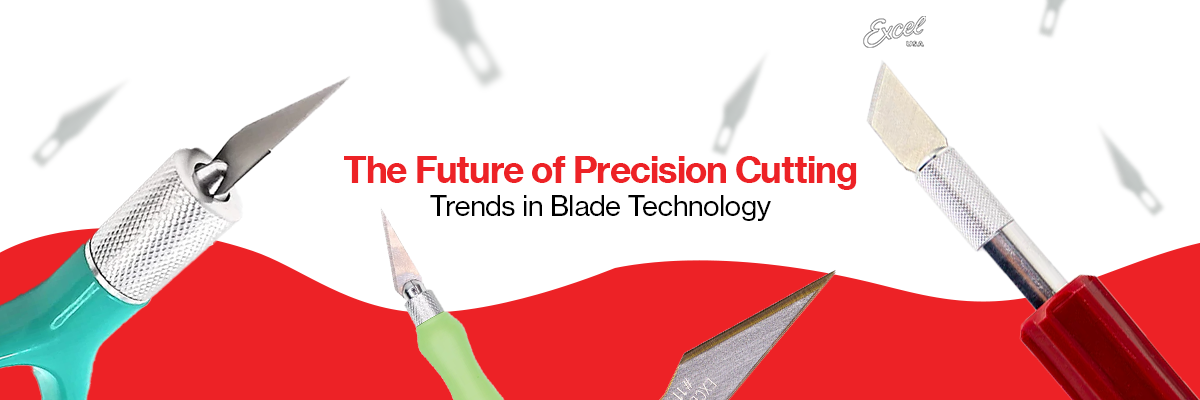
The Future of Precision Cutting: Innovations & Blade Technology Trends
The Future of Precision Cutting: Trends in Blade Technology
Precision cutting has quietly revolutionized everything from industrial manufacturing and medical devices to crafts, model making, and packaging. While a craft knife or utility blade might seem like a simple tool, today’s blade technologies are the result of decades of innovation.
This blog explores the future of precision cutting, diving into trends that are reshaping how blades are designed, produced, and used—especially in sectors like hobby, industrial, and professional use. You’ll also discover how companies like Excel Blades are contributing to these advancements with smart design, material science, and ergonomic innovation.
1. Advanced Blade Materials: Stronger, Sharper, Smarter
Traditionally, blades have been made from stainless or carbon steel, but the next generation of cutting tools is experimenting with composite materials and nanostructured metals. These offer increased durability, corrosion resistance, and edge retention.
- Tungsten carbide, often seen in industrial cutting, is finding its way into precision hobby tools for its extreme hardness.
- Ceramic blades, though brittle, remain sharper for longer and are ideal for precision in applications like medical devices and electronics.
- Excel Blades has integrated carbon steel with high-precision grinding for the hobby blades, striking a balance between sharpness and control.
Source: Journal of Materials Research and Technology, 2023

2. Ergonomic & User-Centered Design
User fatigue is a big issue in fields requiring extended tool use, whether it's packaging, prototyping, or architectural modeling. The future of blade technology includes an increased focus on ergonomic design and customizable tools.
- Soft grip handles, thumb rests, and weighted balance points are becoming industry standards.
- Excel Blades’ K26 Soft Grip Knife demonstrates this trend with a comfortable rubberized grip and improved balance for high-control cuts.
The next step? 3D-printed, personalized handles that match a user’s hand profile.

3. Smart Blades: Sensors & IoT Integration
The rise of smart tools is leading to the development of sensor-integrated cutting systems. Though still in early stages, these tools can:
- Detect blade wear and recommend replacement.
- Alert users to cutting force imbalances that could lead to injury.
- Integrate with inventory systems for automatic resupply.
In industrial settings, these technologies are already in use. For example, smart cutting heads in CNC machines and textile production are monitored in real-time to reduce downtime.
Source: MIT Technology Review, 2024

4. Modularity & Quick-Swap Systems
As multitasking becomes the norm, blade systems are evolving toward modular designs that allow users to quickly swap between blade types, handles, or cutting angles.
- Excel’s Deluxe Knife Sets exemplify this with a variety of blade types and interchangeable handles for model makers, designers, and DIYers.
- Future tools may feature magnet-based quick swap systems or even self-locking blade mechanisms for faster workflow transitions.
This trend improves safety, reduces tool clutter, and increases productivity, especially in professional environments.

5. Sustainability & Eco-Friendly Manufacturing
As industries move toward sustainable practices, blade manufacturing is also evolving:
- Recyclable blade packaging, like paper-based or biodegradable pouches, is replacing clamshell plastic.
- Reusable blade handles and sharpenable blades are rising in popularity among eco-conscious users.
- Excel Blades promotes product longevity by offering refill blade packs and rust-resistant blades that reduce waste.
Expect to see brands adopting closed-loop recycling systems, especially in industries with high blade turnover like textiles and food processing.
Source: Environmental Progress & Sustainable Energy, 2022
6. Precision Micron-Level Cutting
In scientific and medical applications, blades must often cut with sub-millimeter accuracy. The trend of micron-level cutting—achieved through ultra-fine honing techniques and advanced manufacturing—is making its way into commercial markets.
- This benefits model builders and artists working with foam, paper, plastic, and vinyl who require smooth, fiber-free edges.
- Excel Blades offers ultra-precise products like the #64 Stencil Edge Blade, designed for paper cutting, detailing, and other tight-tolerance applications.
As techniques from the aerospace and medical industries trickle down, the average consumer will benefit from sharper, safer tools.

7. Cross-Industry Blade Specialization
The future isn't just about one blade to rule them all. Instead, we're seeing highly specialized blades for niche tasks:
- Scalpel-style blades for vinyl weeding and electronic repair.
- Curved blades and chisel blades for carving foam or clay.
- Micro blades for cutting balsa, resin, or composite model parts.
This specialization mirrors trends in industries like surgery and electronics, where tool specificity directly impacts results.
8. Enhanced Safety Features
As blade technology improves, safety innovations are evolving in parallel:
- Retractable blade designs are becoming standard in utility knives.
- Blades with non-slip coatings and anti-roll handles reduce injury.
- Visual indicators for dull blades (color change, digital alert) are being developed.
Excel Blades offers safety-forward options such as knives with anti-roll safety caps, perfect for classroom or collaborative work environments.

Conclusion: Where Craftsmanship Meets Innovation
Precision cutting is no longer a basic task—it’s an advanced process fueled by material science, digital integration, and user-centered design. Whether you're a maker, crafter, industrial worker, or designer, staying updated on the latest blade technologies can significantly improve your work’s accuracy, efficiency, and safety.
As these innovations become more accessible, brands like Excel Blades continue to bridge the gap between tradition and technology, delivering tools that support creators across industries.